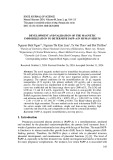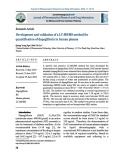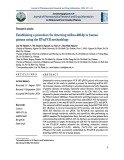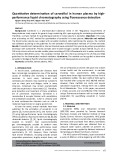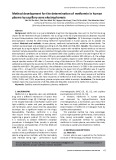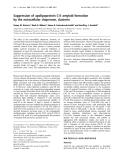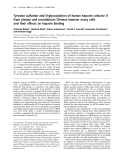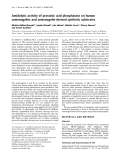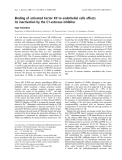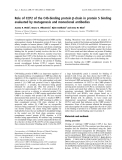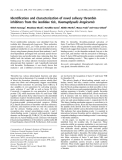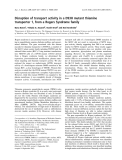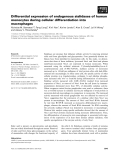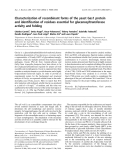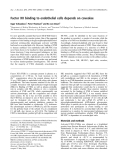
Human plasma
-
The novel magnetic method used to immobilize the primary antibody in 96-well polystyrene plates was investigated to determine the pregnancy-associated plasma protein-A (PAPP-A), one of the most important protein markers in pregnancy.
 9p
9p  viaburame
viaburame
 14-03-2025
14-03-2025
 4
4
 1
1
 Download
Download
-
A specific and sensitive LC-MS/MS method has been developed for determination of dapaglifozin (DAP) in human plasma. DAP and the internal standard (empaglifozin) were extracted from human plasma by liquid-liquid extraction.
 8p
8p  vihyuga
vihyuga
 04-03-2025
04-03-2025
 2
2
 1
1
 Download
Download
-
Quantitative reverse transcription PCR (RT-qPCR) paired with stem-loop was utilized in this study to establish a process for detecting miRNA-425-5p in human plasma, contributing to accurate prognosis and early diagnosis of genetic diseases in humans, especially cancer diseases. Blood samples (n=12) collected from healthy volunteers in Ho Chi Minh City, were subjected to plasma extraction and then microRNA (miRNAs) isolation using the TRIzol method.
 11p
11p  vihyuga
vihyuga
 04-03-2025
04-03-2025
 6
6
 1
1
 Download
Download
-
Carvedilol is a pharmaceutical substance listed in the “Regulatory requirements of bioequivalence study reports for generic drugs containing APIs upon applying for marketing authorization”. Therefore, a simple method for quantifying carvedilol in human plasma is desirable.
 6p
6p  vihatake
vihatake
 06-01-2025
06-01-2025
 3
3
 2
2
 Download
Download
-
Metformin is an oral antidiabetic drug from the biguanide class and it is the first-line drug chosen for the treatment of type 2 diabetes. This is a drug on the list of pharmaceutical substances required to report bioequivalence study data when registering the drug. Objectives: (1) To develope a capillary zone electrophoresis method for determining metformin hydrochloride in human plasma. (2) To validate the method.
 10p
10p  viuchiha
viuchiha
 03-01-2025
03-01-2025
 4
4
 2
2
 Download
Download
-
The effect of the extracellular chaperone, clusterin, on amyloid fibril formation by lipid-free human apolipoprotein C-II (apoC-II) was investigated. Sub-stoichiometric levels of clusterin, derived from either plasma or semen, potently inhibit amyloid formation by apoC-II. Inhibition is dependent on apoC-II concentration, with more effective inhibition by clusterin observed at lower concentrations of apoC-II. The average sedimentation coefficient of apoC-II fibrils formed from apoC-II (0.3 mgÆmL)1) is reduced by coincubation with clusterin (10 lgÆmL)1). ...
 6p
6p  system191
system191
 01-06-2013
01-06-2013
 37
37
 3
3
 Download
Download
-
Selenoprotein P (SeP) is a plasma protein that contains up to 10 selenocysteine residues and accounts for about 50% of total selenium in human plasma. We have previously shown that SeP expression in the human liver cell line HepG2 is inhibited by transforming growth factor (TGF)-b1 on a transcriptional level. Smad proteins are the transcriptional mediators of TGF-b signalling and putative Smad-binding elements (SBE) comprising the core sequence CAGACA are present at two positions in the SeP promoter....
 6p
6p  system191
system191
 01-06-2013
01-06-2013
 37
37
 4
4
 Download
Download
-
Murine pregnancy-associated plasma protein-A (PAPP-A) cDNA encoding a 1545 amino-acid protein has been cloned. We have also identified and cloned cDNA that encodes a novel variant of PAPP-A, PAPP-Ai, carrying a 29-residue highly basic insert. The point of insertion corresponds to a junction between two exons in the human PAPP-A gene. The human intron flanked by these exons does not encode a homologous corresponding insert, which is unique to the mouse.
 10p
10p  research12
research12
 01-06-2013
01-06-2013
 44
44
 6
6
 Download
Download
-
Subunits (a, b and c) of the interleukin-2 receptor complex (IL-2R) are involved in both proliferative and activationinduced cell death (AICD) signaling of T cells. In addition, the signaling b and c chains are shared by other cytokines (e.g. IL-7, IL-9, IL-15). However, the molecular mechanisms responsible for recruiting/sorting the a chains to the signaling chains at the cell surface are not clear.
 10p
10p  research12
research12
 01-06-2013
01-06-2013
 33
33
 5
5
 Download
Download
-
The structure of post-translational modifications of human heparin cofactor II isolated from human serum and from recombinant Chinese hamster ovary cells and their effects on heparin binding have been characterized. Oligosaccharide chains were found attached to all three potential N-glycosylation sites in both protein preparations. The carbohydrate structures of heparin cofactor II circulating in blood are complex-type diantennary and triantennary chains in a ratio of 6 : 1 with the galactose being 90% sialylated with a2 fi 6 linked N-acetylneuraminic acid....
 12p
12p  research12
research12
 01-06-2013
01-06-2013
 44
44
 3
3
 Download
Download
-
Undifferentiated human promyelocytic leukemia HL-60 cells show little or no superoxide production, but generate a very low O2 – concentration upon incubation with all-trans-retinoic acid (ATRA). Its production reaches a maximum within 20 h, and thereafter is maintained at an almost con-stant level. The differentiated cells show phorbol 12-myri-state 13-acetate (PMA)-stimulatedNADPHoxidase activity consistent with the amount of gp91phox(phagocytic oxid-ase) expressed in the plasma membrane.
 8p
8p  research12
research12
 29-04-2013
29-04-2013
 37
37
 5
5
 Download
Download
-
In addition to kallikrein hK3, a serine protease generally reported as PSA (prostate-speci®c antigen), at least two other enzymes in human seminal plasma also cleave syn-thetic peptidyl substrates derived from the sequence of human semenogelins. We have identi®ed one of these as prostatic acid phosphatase (PAP), a major component of prostatic ¯uid whose physiological function is unclear.
 6p
6p  research12
research12
 29-04-2013
29-04-2013
 34
34
 4
4
 Download
Download
-
A high-affinity monoclonal antibody (M27), raised against the human thrombin–antithrombin complex, has been identifiedand characterized. The epitope recognizedbyM27 was located to the linear sequence FIREVP (residues 411– 416), located in the C-terminal cleavage peptide of anti-thrombin.This regionoverlaps, by two residues, theputative binding site of antithrombin for the serpin–enzyme complex receptor.
 11p
11p  tumor12
tumor12
 20-04-2013
20-04-2013
 37
37
 4
4
 Download
Download
-
It is well known that activated Factor XII (FXIIa) and kallikrein are rapidly inactivated in plasma as a result of reaction with endogenous inhibitors. The purpose of this may be to prevent uncontrolled deleterious spreading and activation of target zymogens. Both FXII and the complex plasma prekallikrein/high molecular mass kininogen become activated when they bind, in a Zn 2+ -dependent manner, to receptors on human umbilical vein endothelial cells (HUVEC).
 8p
8p  tumor12
tumor12
 20-04-2013
20-04-2013
 31
31
 2
2
 Download
Download
-
Complement regulator C4b-binding protein (C4BP) and the anticoagulant vitamin K-dependent protein S form a high affinity complexin human plasma. C4BP is composed of sevena-chains and a uniqueb-chain, each chain comprising repeating complement control protein (CCP) modules. The binding site for protein S mainly involves the first of the threeb-chain CCPs (CCP1). However, recently it has been suggested that CCP2 of theb-chain also contributes to the binding of proteinS.
 8p
8p  tumor12
tumor12
 20-04-2013
20-04-2013
 35
35
 2
2
 Download
Download
-
Novel antithrombin molecules were identified from the ixodidae tick, Haemaphysalis longicornis. These molecules, named madanin 1 and 2, are 7-kDa proteins and show no significant similarities to any previously identified proteins. Assays using human plasma showed that madanin 1 and 2 dose-dependently prolonged both activated partial throm-boplastin time and prothrombin time, indicating that they inhibit both the intrinsic and extrinsic pathways. Direct binding assay by surface plasmon resonance measurement demonstrated that madanin 1 and 2 specifically interacted with thrombin....
 9p
9p  fptmusic
fptmusic
 16-04-2013
16-04-2013
 50
50
 3
3
 Download
Download
-
Rogers syndrome is an autosomal recessive disorder result-ing in megaloblastic anemia, diabetes mellitus, and sensori-neural deafness. The gene associated with this disease encodes for thiamine transporter 1 (THTR1), a member of the SLC19 solute carrier family including THTR2 and the reduced folate carrier (RFC). Using transient transfections into NIH3T3 cells of a D93H mutant THTR1derived from a Rogers syndrome family, we determined the expression, post-translational modification, plasma mem-brane targeting and thiamine transport activity.
 9p
9p  fptmusic
fptmusic
 12-04-2013
12-04-2013
 49
49
 3
3
 Download
Download
-
Sialidases are enzymes that influence cellular activity by removing terminal sialic acid from glycolipids and glycoproteins. Four genetically distinct sia-lidases have been identified in mammalian cells. In this study, we demon-strate that three of these sialidases, lysosomal Neu1 and Neu4 and plasma membrane-associated Neu3, are expressed in human monocytes.
 12p
12p  awards
awards
 06-04-2013
06-04-2013
 30
30
 4
4
 Download
Download
-
Gas1p is a glycosylphosphatidylinositol-anchored plasma membrane glycoprotein ofSaccharomyces cerevisiaeand is a representative of Family GH72 of glycosidases/transgly-cosidases, which also includes proteins from human fungal pathogens. Gas1p, Phr1-2p from Candida albicansand Gel1p fromAspergillus fumigatushave been shown to be b-(1,3)-glucanosyltransferases required for proper cell wall assembly andmorphogenesis. Gas1p is organized into three modules: a catalytic domain; a cys-richdomain; andahighly O-glycosylated serine-rich region. ...
 11p
11p  awards
awards
 05-04-2013
05-04-2013
 48
48
 4
4
 Download
Download
-
It is now generally accepted that factor XII (FXII) binds to cellular surfaces in the vascular system. One of the suggested receptors of this binding is the glycosylphosphatidylinositol-anchored urokinase-like plasminogen activator (u-PAR) harbored in caveolae/lipid rafts. However, binding of FXII to human umbilical vein endothelial cells (HUVEC) has never been shown to be localized to these specialized mem-brane structures. Using microscopical techniques, we here report that FXII binds to specific patches of the HUVEC plasma membrane with a high density of caveolae....
 8p
8p  awards
awards
 05-04-2013
05-04-2013
 45
45
 6
6
 Download
Download
CHỦ ĐỀ BẠN MUỐN TÌM








